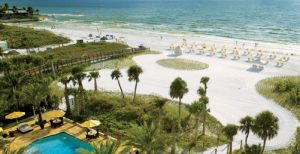Home Sales Jump as Season Winds Down

 Homes sales in Southwest Florida heated up in March, rising 8.6 percent over the year as the real estate market sailed into the end of the peak-selling season.
Homes sales in Southwest Florida heated up in March, rising 8.6 percent over the year as the real estate market sailed into the end of the peak-selling season.
After a cool-off in 2016 — which followed two record years — sales of previously owned single-family homes and condominiums so far in 2017 are 4.1 percent ahead of last year’s pace in Sarasota, Manatee and Charlotte counties, according to data released Friday by the Florida Realtors trade group.
While buying a home continues to get more expensive, re-sales were bolstered in part by a growing inventory of active listings for shoppers to browse.
“It’s common to see an increase in sales when we near the end of our season,” said Xena Vallone, president of the Realtor Association of Sarasota and Manatee. “And the bump in pending sales in March will likely lead to more closed sales in April and May.”
Buyers closed on 2,605 homes and condos in the three-county region in March, or 207 more than last year, during what is traditionally a busy month for sales.
Sales of single-family homes in March surged 11.7 percent in Manatee and 24.2 percent in Charlotte, while increasing a modest 2.6 percent in Sarasota.
Prices continued their steady growth clip. In Sarasota County, single-family homes sold for a median $262,621 last month, up 7.6 percent over the year. In Manatee, the median price climbed 7.4 percent to $290,000. And in Charlotte, homes traded for $210,000, a 7.7 percent gain.
“Typically, there are more homes available above the respective median price point for each county,” Vallone said. “With a lower supply of single-family homes listed under $300,000, we see that the median time to contract is shorter for these homes than it is for the homes listed in the higher ranges. Buyers are quicker to jump on a sale when they know their supply is limited.”
- The inventory of homes for sale rose by 13 percent in Sarasota and by 10.5 percent in Manatee over the year, RASM reported. Sarasota had more homes for sale in the $200,000 to $299,999 price range, while Manatee had more homes listed in the $300,000-$399,999 range.
- Pending sales — those under contract but not closed — were 6.1 percent ahead of last year.
- Condo sales increased 5.8 percent in the Sarasota-Manatee region last month. Prices rose 13.3 percent to a median $205,000.
In Charlotte, condo sales grew 6.1 percent. Prices gained 3.3 percent, to $159,000.
Statewide
Statewide, buyers closed on 25,921 single-family homes in March, up 9.3 percent. Condo sales rose 11.4 percent to 11,193.
Homes throughout Florida traded for a median $231,900, 10.4 percent more than last year, while condos sold for $171,000, a 9.4 percent gain.
“March turned out to be one of the strongest months we’ve seen in a long time for sales of existing homes in the Sunshine State,” said Brad O’Connor, chief economist at Florida Realtors. “Sales for both single-family homes and for townhouse-condo units in March marked the fourth-highest monthly total for any single month over the past decade.
“The data shows that inventory levels in the more affordable price tiers continue to fall, especially in the case of single-family homes,” he said. “The number of active single-family home listings was down almost 5 percent year-over-year at the end of March. As a result, the single-family sector remained a seller’s market, though the inventory situation in the townhouse-condo market appears more balanced.”
Nationwide
Nationwide, Americans purchased homes in March at the fastest pace in over a decade, a strong start to the traditional spring buying season.
Sales of existing homes climbed 4.4 percent last month to a seasonally adjusted annual rate of 5.71 million, the National Association of Realtors said. That was the fastest sales rate since February 2007.
The U.S. housing market faces something of a split personality: A stable economy has intensified demand from would-be buyers, but the number of properties listed for sale has been steadily fading. The result of this trend is prices rising faster than incomes, homes staying on the market for fewer days, and a limit on just how much home sales can grow. It’s a situation that rewards would-be buyers who can act quickly and decisively.
“The pace of sales we saw in March is unsustainable,” said Nela Richardson, chief economist at the brokerage Redfin. “Sales may be soaring, but inventory isn’t.”
The inventory shortage largely reflects the legacy of a housing bubble that began to burst a decade ago.
Foreclosed properties were snapped up by investors who turned the homes into income-generating rentals, depriving the market of supply. And many owners who escaped the downturn unharmed chose to refinance their mortgages at extremely low rates, possibly making them hesitant to move to a new house that could increase their monthly costs.
This mismatch between supply and demand can be seen in two simple figures tracked by the Realtors.
Sales have risen 5.9 percent over the past year, but the inventory of homes for sale has fallen 6.6 percent to 1.83 million properties. This means there are essentially more buyers chasing fewer properties.
The consequences can be seen in home values and days on the market. The median sales price in March climbed 6.8 percent over the past year to $236,400, significantly outpacing wage growth. And it took an average of 34 days to complete a sale, compared to 47 days a year ago.
Herald Tribune – April 21, 2017